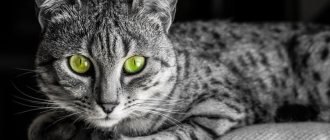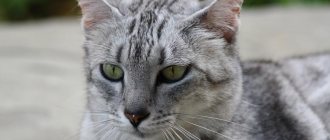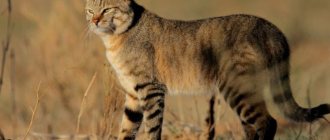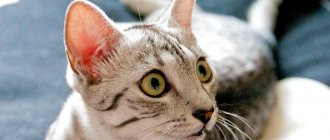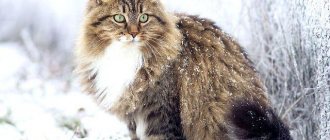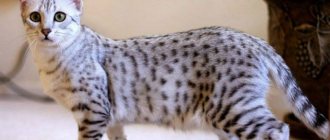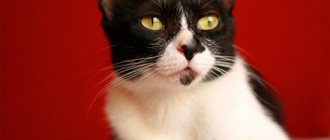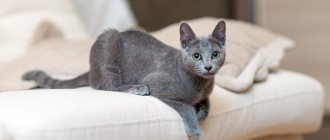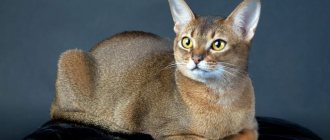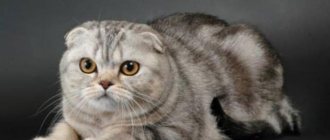Brief history of the breed
The Egyptian Mau is one of the oldest breeds. It is believed to have descended from the African wild cat.
Residents of the Nile Valley noticed that where spotted cats live, there are practically no mice and rats, which means that grain reserves remain intact, and epidemics of deadly diseases quickly die out. People began to gradually domesticate these animals, and by the time of the advent of the New Kingdom, the Mau were not only completely domesticated, but also began to be considered sacred.
Figures of cats similar to modern Mau are found on most ancient Egyptian bas-reliefs. They were painted next to images of pharaohs and their wives. Killing these animals was punishable by law. And the mummy of the deceased cat was placed in an expensive sarcophagus and buried with honors.
With the disappearance of the great dynasties of the pharaohs, the Mau cult came to naught and by the beginning of the 20th century it could only be learned about from legends and historical literature. However, the cats themselves have not gone away. They still lived in Egypt and even in Europe. But after World War II, their existence was under threat.
The revival of the Egyptian Mau began with the light hand of Natalia Trubetskoy. When a Russian princess accidentally ended up with a cat that looked like animals from ancient bas-reliefs, the woman began to study the history of these graceful creatures. Later, thanks to a high-ranking diplomat, the princess received another pair of Mau from Egypt - a male and a female. Having moved to America, Trubetskoy opened the Fatima cattery and in 1968 registered the Egyptian Mau cat breed with the CFA.
Interesting Facts
During the existence of the Egyptian Mau, many interesting things have been associated with the breed:
- Once upon a time, the most ancient cats were identified with deities. They were worshiped during life, they were mourned after death. To perpetuate the memory of a departed cat, the owner shaved off his eyebrows and reproduced her image on papyrus.
- Egyptian Mau cats have a quiet, musical voice. When they are in a good mood, they make sounds similar to birds giggling or chirping.
- The Mau had a special place in ancient Egyptian culture. Archaeologists managed to discover an ancient cat cemetery with 1,800 places. The mummified remains of the Mau were found there, encased in silver and gold sarcophagi.
How much is the Egyptian Mau worth?
The Egyptian Mau breed is one of the rarest and most expensive. The price of a cat starts from 50 thousand rubles. The more the animal meets the standard, the higher the cost. You can “save” only on black Egyptian Mau. Since the characteristic spots merge with the main color of the coat, such specimens are considered rejected and are not allowed for breeding work or participation in exhibitions. However, if you are looking for a loyal and cheerful friend, the special color should not be an obstacle to acquiring an Egyptian Mau.
Breed description, standards, appearance
The Egyptian Mau is a massive cat, not without graceful lines. Outwardly, she vaguely resembles an Abyssinian, and her appearance combines mobility and heaviness. A detailed description of the breed is presented in the generally accepted standard.
Dimensions and weight
The Egyptian cat is a medium-sized animal. The breed has developed sexual dimorphism, which is why females are slightly lighter than males. The cat weighs 3-4.5 kg. The cat's weight is 4.5-6 kg.
Anatomical characteristics
A purebred Egyptian Mau looks like this:
- The head is small, wedge-shaped with smooth lines, a rounded forehead and a flat muzzle. High cheekbones, feet without sharp bends or kinks. The chin is small and strong. The nose is wide, with a hump.
- The ears are triangular, wide at the base, with pointed tips. The outside is covered with short hair. Slightly tilted forward.
- The eyes are large, slanting, widely set. Young Egyptian cats have amber colored irises. But after one and a half years it acquires a light green tint.
- The body is elongated, elegant, with developed muscles, a straight back and a smoothly curved neck. The Egyptian Mau has a fold of skin on its belly that makes the cat's movements easier and more flexible. It is implied that thanks to it these cats are able to reach speeds of 48 km/h.
- The limbs are strong and muscular. The front ones are slightly shorter than the rear ones. Paws are oval or rounded.
- The tail is of medium length, gradually tapering from the base to a dark, cone-shaped tip.
Color and coat type
The body of the Egyptian cat is covered with a short, close-fitting awn. Despite the insignificant thickness of the wool, it perfectly protects the animal from bad weather.
On a note. The texture of the coat of Egyptian cats depends on the color. Smoky individuals have smooth and silky fur. Bronze and silver representatives of the breed have a tougher coat.
International standards for Egyptian cats allow only 3 color options. The following colors are acceptable in the breed:
- Smoky with silver undercoat and contrasting points. The main tone is dark gray, almost black.
- Bronze with brown markings on the body and the same tips on the ears. Cream fur grows on the throat, chin and around the eyes. The belly is colored light, almost milky. The bridge of the nose has an ocher, brownish-red color.
- Silver with contrasting points and dark ear tips. White hair grows on the neck, chin and near the nostrils. The nose, eye contours and lip rims are black.
We recommend an interesting article about cats that look like a tiger.
Silver and bronze representatives of the breed are characterized by ticking. But smoky Egyptian cats do not have it.
On a note. The main distinguishing feature of representatives of one of the most ancient cat breeds is the presence of a pattern in the form of a scarab beetle, located on the forehead and between the ears of the Mau.
Possible breed defects
Disadvantages of the exterior, in the presence of which the Egyptian cat will not receive a high expert assessment:
- small eyes;
- merging marks;
- excessively large or small ears;
- points in the form of stripes;
- no spots on the belly;
- small or round head;
- thin or short tail;
- undeveloped chin;
- pointed or short muzzle.
Disqualifying faults:
- white points;
- lack of ticking in silver and bronze individuals;
- “medallions” on the chest;
- ticking in smoky individuals;
- atypical eye pigmentation;
- complete absence of stains;
- deformed bone;
- cryptorchidism (in males);
- deafness;
- amputated claws.
Color
An interesting color feature is the silhouette of a scarab beetle, which is located on the forehead.
There are three main types of coloration of the Egyptian Mau.
- Bronze. The base tone is dark brown to ivory. The design is made in dark brown, and the edging of the eyes and nostrils is cream.
- Silver. The main color is gray and light gray. The edging of the eyes and nostrils is black. The pattern is made in dark gray and black.
- Smoky. The main color is from dark gray to black. Drawing in black.
There are cases when both black and marbled maus are born. Non-standard colors are called “wild”. And unfortunately, cats of this color cannot participate in breeding.
Character and temperament
Egyptian cats are balanced animals that cope well with the role of a companion. Mau quickly get used to people, although they do not suffer from prolonged separation. Energetic representatives of the breed poke their curious noses everywhere and cannot sit still for long.
The Egyptian Mau has an ambiguous character. A developed sense of self-esteem prevents her from silently enduring annoying advances. Therefore, it is not recommended to have a cat of this breed for families in which children are growing up. But the Egyptian Mau can easily find a common language with older children.
Representatives of the breed get along without problems not only with their relatives, but also with friendly dogs. But Egyptian cats consider fish, ornamental rodents and birds as prey and actually hunt for them.
Mr. Cat recommends: living with other animals
Mau cats get along differently with other pets. More often it depends on the individual character of the animal. They get along well with other cats, but it is not recommended to keep representatives of Asian breeds with them. Both are self-sufficient leaders, which means competitive behavior can develop between cats.
Mau dogs get along worse with dogs, preferring to ignore them. Jealous individuals can openly provoke dogs into aggression.
It is best to keep birds and rodents as far away from Egyptian cats as possible. The hunting instinct will not allow them to come to terms with the smells and sounds of potential prey. The presence of a mouse and a bird in the house one way or another threatens trouble. Either the cat will get there and eat it, or it will experience severe anxiety, which can turn into neurosis.
How to choose the right kitten
To be sure that your Egyptian cat is purebred, it is advisable to buy it from a specialized nursery or from a trusted breeder. It’s better to choose a baby not based on photos and videos, but in person.
This way, the potential owner of an Egyptian Mau kitten will have the opportunity to personally check the availability of documents confirming that they belong to the breed and evaluate the living conditions of the animals.
Kids should be actively interested in everything that happens around them and play with each other. Healthy Egyptian kittens should have clear eyes, clean ears, soft bellies, smooth skin without scratching, and a uniform coat without bald spots. It is important that little Mau do not have dirt under their tails or bad breath.
Kitten care
Until 12 weeks, kittens live with their mother. By the time they move to a new home, little Mau are already completely independent. They eat many foods with appetite, know how to use a scratching post and are litter trained. Therefore, new owners can only give the Egyptian kitten time to get used to the changed conditions and show where the tray with filler and bowls with water and food are located.
For safety reasons, all wires, household chemicals, ornamental plants, fragile and small objects are removed from the playful pet.
In order for an Egyptian kitten to grow well and develop properly, it is provided with adequate nutrition. And the Mau feeding schedule is set taking into account its age:
- up to 2 months – 5-6 times a day;
- 2-5 months – 4 times a day;
- 5-12 months – 3 times a day.
A one-year-old Egyptian cat is being fed twice a day.
Care and maintenance
Egyptian Mau are unpretentious cats that quickly adapt to different conditions. They can be kept in a spacious country house or in a small city apartment. Representatives of the breed are characterized by increased cleanliness, so caring for them does not take much time and effort.
To keep the short hair of the Egyptian Mau looking neat, it is brushed 2-3 times a week with a special brush or mitten. This simple procedure will help get rid of dead hair and strengthen the hair follicles. Representatives of the breed are bathed no more than once a quarter, and some owners do not give their Mau baths at all.
The eyes and ears of the Egyptian cat are wiped with damp cotton swabs as needed and periodically inspected for unusual discharge.
Mau teeth are cleaned 1-2 times a month using a non-foaming paste applied to a brush or a special attachment. This simple procedure will prevent the formation of stones and help remove yellowish plaque.
As they grow, the claws of the Egyptian Mau are shortened with a claw clipper, and sharp edges and jagged edges are sharpened with a nail file.
Diseases
Since modern representatives of the Egyptian breed were bred using a limited type, hereditary ailments rarely bypass the Mau.
First of all, as breeders warn, the respiratory system of cats suffers. Egyptian Mau are prone to asthma, sinusitis, and allergies, so do not smoke in the room where your pet lives, protect it from harsh scents, and do not let it dig in the dust.
Cardiomyopathy, unfortunately, is also common. It is impossible to predict its development, however, if you notice the first signs of pathology (shortness of breath, fatigue, decreased activity), take your cat to the veterinarian. With medications it will be possible to improve life and prolong it.
Even if your pet lives indoors and does not go outside, it should be vaccinated according to the vaccination schedule and dewormed once a quarter. Castration and sterilization are mandatory if you do not plan to breed. These cats' hormones play too much, so you shouldn't torture them.
Feeding the cat
The Egyptian Mau can be given both commercial and natural food. When feeding dry food to a cat, premium or super-premium products are selected, which do not contain dyes, preservatives or other dubious additives.
The following brands of food best fit these criteria:
- Pronature;
- Hills;
- Brit Care;
- Gemon.
With the natural type of feeding, the Egyptian Mau is given predominantly lean, fresh meat. Also included in the cat’s diet:
- boiled vegetables;
- porridge with water;
- offal;
- eggs;
- dairy products;
- lean sea fish.
Egyptian cats should not be fed sausages, bones, sweets, baked goods or mushrooms. Also, representatives of the breed are prohibited from giving river fish, pickles, smoked meats and any food from the master’s table.
Education and physical activity
Egyptian Mau are endowed with high intelligence and excellent memory. Cats of this breed quickly understand what is required of them. They get used to the tray and scratching post without any problems. If desired, the Mau can be trained to walk on a leash and learn to follow simple commands.
Egyptian cats have an energetic temperament. Active and jumping Mau easily overcome obstacles and climb high furniture.
To realize hunting instincts, representatives of the breed can purchase several interactive toys. And to maintain the physical shape of the Mau, it is recommended to equip a corner with multi-level platforms and ladders.
Education and training
Egyptian cats are very smart, they have extraordinary intelligence and are very obedient. They will understand the owner practically from the first words, but it is not recommended to punish them. In mastering the rules of behavior, it is enough to talk strictly to your pet, and under no circumstances shout or hit. The animal will remember this behavior, but will not understand the reason for the owner’s aggression.
Egyptian cats are almost not touchy, but the owner’s aggression can frighten the pet for a long time
When raising a Mau, it is enough to show persistence and affection, to give the pet time to get used to it and get comfortable. The advantage of a cat of this breed is that they very well perceive a person’s tone, his facial expression and literally “read” dissatisfaction. To reinforce it, you can indicate to the animal with a prohibiting gesture, which almost always works flawlessly.
Health and susceptibility to disease
Egyptian Mau have good immunity and live on average about 16 years. Although these cats are in good health, they are predisposed to certain pathologies. Most often, representatives of the breed are diagnosed with the following diseases:
- asthma;
- dystonia;
- subluxation of the kneecap;
- cardiomyopathy.
On a note. Some breed lines have a predisposition to allergies. Therefore, before purchasing an Egyptian Mau, it is advisable to clarify this point with the breeder.
Health
In the 1950s, when the Egyptian Mau first arrived in the United States, interbreeding and a small gene pool gave rise to the development of some inherited diseases. Feline asthma and serious heart problems were consequences.
However, breeders have worked hard to eliminate these problems, including importing cats from India and Egypt.
The Mau's health has improved significantly, but some problems remain, such as allergies to certain foods. In addition, some lines have not yet completely eliminated genetic diseases, so it makes sense to talk to the owner about your cat's heredity.
If you want a pet and do not plan to participate in the show, then it makes sense to buy a black Egyptian Mau. She also has spots, but they are quite difficult to see. Black Mau are sometimes used for breeding, but rarely and usually they are several times cheaper than regular ones, as they are considered a cull.
However, apart from the color of their coat, they are no different from the classic Mau, and fanciers say that their coat is softer and more beautiful.
Vaccinations and antiparasitic treatment
To prevent infectious and viral diseases, the Egyptian Mau is regularly administered a complex vaccine against calcivirosis, rhinotracheitis and panleukopenia. The first vaccination is given to a kitten at the age of 7-8 weeks. After 4 weeks, he will be revaccinated against the same diseases and against rabies. In the future, the Egyptian Mau is vaccinated once a year.
To protect your cat from diseases carried by parasites, it is regularly treated for fleas and helminths. Antihelminthic drugs for the Egyptian Mau are given once every six months with mandatory repetition after 10-14 days.
For fleas, a cat of this breed is treated with special drops or shampoos. And if the Mau regularly goes outside, she is additionally put on an anti-parasitic collar.
Pros and cons of the breed
Like any other cat breed, the Egyptian Mau has its own advantages and disadvantages.
| pros | Minuses |
| High intelligence | Independent character |
| Visual appeal | The habit of loudly expressing emotions |
| Cleanliness | High cost of kittens |
The Egyptian Mau is a beautiful green-eyed cat with an exquisite spotted coat. She is endowed with a playful character and developed hunting instincts. Due to its active temperament and natural curiosity, a cat of this breed will be an excellent companion for people who dream of an attractive and energetic pet.
Application
What use can a cat have other than being a pet? But the Egyptian Mau can boast of hunter skills.
Thanks to its excellent eyesight and hearing, the animal, like the bobtail-Kuril cat , deftly hunts for small rodents.
In addition, this breed is a real running champion among cats. There is no other breed that can reach speeds of up to 58 km/h.
The Egyptian Mau is a true running champion among cats. There is no other breed that can reach speeds of up to 58 km/h
